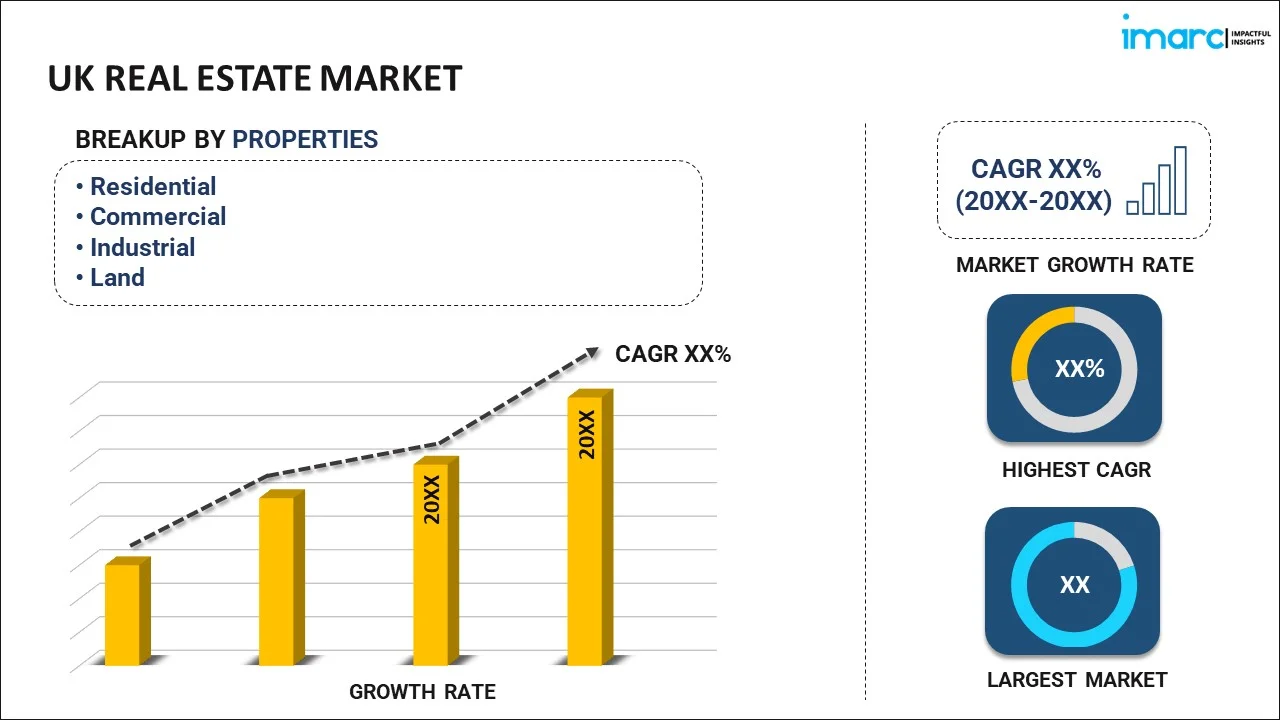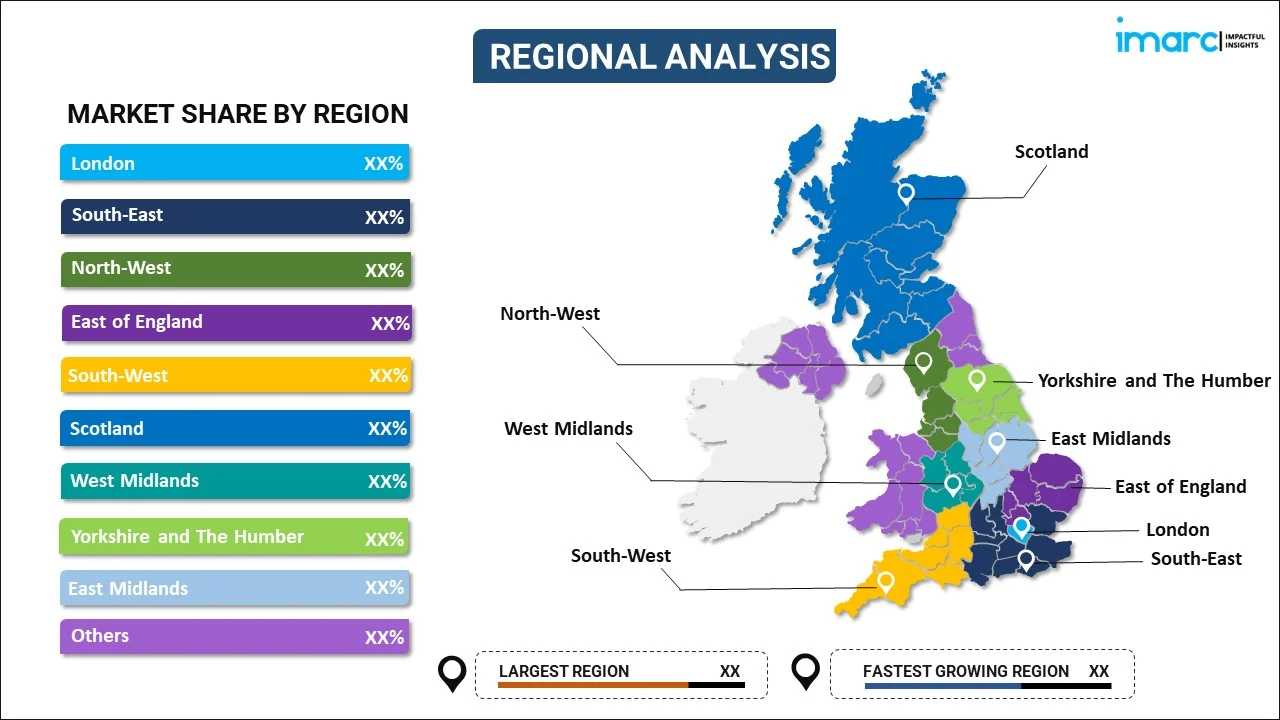
UK Real Estate Market Report by Property (Residential, Commercial, Industrial, Land), Business (Sales, Rental), Mode (Online, Offline), and Region 2024-2032
UK Real Estate Market Overview:
The UK real estate market is projected to exhibit a growth rate (CAGR) of 5.50% during 2024-2032. The market is experiencing steady growth, driven by affordable mortgages due to low interest rates, impactful government policies such as higher stamp duty rates for non-residents, and overseas capital, especially in luxury and commercial real estate.
|
Report Attribute
|
Key Statistics
|
|---|---|
|
Base Year
|
2023 |
|
Forecast Years
|
2024-2032
|
|
Historical Years
|
2018-2023
|
| Market Growth Rate (2024-2032) | 5.50% |
UK Real Estate Market Trends:
Economic Stability
Economic stability is a crucial driver of the UK real estate market, influencing buyer confidence and investment activity. A stable economy often correlates with low unemployment rates, steady wage growth, and robust consumer confidence, all of which encourage spending and investment in housing. When people feel secure in their financial future, they are more likely to commit to purchasing homes, leading to increased demand and higher property prices. Moreover, economic stability typically ensures a low-interest-rate environment. Low interest rates make mortgages more affordable, increasing the number of potential homebuyers in the market. This factor not only stimulates demand but also helps elevate property prices as more people can borrow money to buy real estate. The correlation between economic stability and real estate dynamics highlights the sensitivity of the property market to broader economic conditions. For instance, during economic downturns, the real estate market tends to slow due to increased unemployment and reduced consumer confidence, demonstrating the direct impact of economic health on real estate activities. Furthermore, favorable government policies such as "Help to Buy" and "Shared Ownership" also play a fundamental role in shaping the dynamics of the UK real estate market. Various initiatives, from tax incentives to housing schemes, directly influence market trends and augment market growth.
Foreign Investment
Foreign investment continues to be a major influence on the UK real estate market, particularly in prime segments such as London’s luxury property and commercial real estate sectors. Investors from overseas are drawn to the UK market due to its political stability, strong legal framework for property rights, and perceived economic security. This influx of capital from abroad drives up property values, especially in high-demand areas, leading to an increase in market prices that can outpace local income growth. This phenomenon can create affordability issues for residents but also contributes to the dynamism and liquidity of the real estate market. Furthermore, the UK government has occasionally intervened to temper the pace of price growth driven by foreign investment, such as through the introduction of higher stamp duty rates for non-resident buyers. These measures aim to control the impact of foreign investment on the market and ensure that the housing market remains accessible to domestic buyers, illustrating the delicate balance required to manage external capital inflows in the real estate sector.
UK Real Estate Market News:
- On May 16, 2024, Bellway and Latimer, in a joint venture to develop Springstead Village in Cherry Hinton, unveiled archaeological discoveries of prehistoric, Anglo-Saxon, and Medieval artifacts at an open day event. The project plans for 1,200 new homes, community facilities, and educational institutions were shared with residents on May 11. Archaeologists from the Cambridge Archaeological Unit led the investigation, uncovering the site's rich history.
- On April 30, 2024, St George and SEGRO opened SEGRO V-Park Grand Union, a six-story, sustainable industrial development in Alperton, as part of the larger 22-acre Grand Union regeneration project. The building offers 134,500 sq ft of floorspace on a 1.7-acre site, aligning with the London Plan to intensify industrial land use, and is expected to support 250 jobs and apprenticeships. This development is part of a broader transformation of a former brownfield site into a vibrant neighborhood with 3,350 homes, 35% affordable, and public green spaces.
UK Real Estate Market Segmentation:
IMARC Group provides an analysis of the key trends in each segment of the market, along with forecasts at the country level for 2024-2032. Our report has categorized the market based on property, business, and mode.
Property Insights:

- Residential
- Commercial
- Industrial
- Land
The report has provided a detailed breakup and analysis of the market based on the property. This includes residential, commercial, industrial, and land.
Business Insights:
- Sales
- Rental
A detailed breakup and analysis of the market based on the business have also been provided in the report. This includes sales and rental.
Mode Insights:
- Online
- Offline
The report has provided a detailed breakup and analysis of the market based on the mode. This includes online and offline.
Regional Insights:

- London
- South East
- North West
- East of England
- South West
- Scotland
- West Midlands
- Yorkshire and The Humber
- East Midlands
- Others
The report has also provided a comprehensive analysis of all the major regional markets, which include London, South East, North West, East of England, South West, Scotland, West Midlands, Yorkshire and The Humber, East Midlands, and Others.
Competitive Landscape:
The market research report has also provided a comprehensive analysis of the competitive landscape in the market. Competitive analysis such as market structure, key player positioning, top winning strategies, competitive dashboard, and company evaluation quadrant has been covered in the report. Also, detailed profiles of all major companies have been provided.
UK Real Estate Market Report Coverage:
| Report Features | Details |
|---|---|
| Base Year of the Analysis | 2023 |
| Historical Period | 2018-2023 |
| Forecast Period | 2024-2032 |
| Units | xx |
| Scope of the Report | Exploration of Historical Trends and Market Outlook, Industry Catalysts and Challenges, Segment-Wise Historical and Future Market Assessment:
|
| Properties Covered | Residential, Commercial, Industrial, Land |
| Businesses Covered | Sales, Rental |
| Modes Covered | Online, Offline |
| Regions Covered | London, South East, North West, East of England, South West, Scotland, West Midlands, Yorkshire and The Humber, East Midlands, Others |
| Customization Scope | 10% Free Customization |
| Post-Sale Analyst Support | 10-12 Weeks |
| Delivery Format | PDF and Excel through Email (We can also provide the editable version of the report in PPT/Word format on special request) |
Key Questions Answered in This Report:
- How has the UK real estate market performed so far and how will it perform in the coming years?
- What has been the impact of COVID-19 on the UK real estate market?
- What is the breakup of the UK real estate market on the basis of property?
- What is the breakup of the UK real estate market on the basis of business?
- What is the breakup of the UK real estate market on the basis of mode?
- What are the various stages in the value chain of the UK real estate market?
- What are the key driving factors and challenges in the UK real estate?
- What is the structure of the UK real estate market and who are the key players?
- What is the degree of competition in the UK real estate market?
Key Benefits for Stakeholders:
- IMARC’s industry report offers a comprehensive quantitative analysis of various market segments, historical and current market trends, market forecasts, and dynamics of the UK real estate market from 2018-2032.
- The research report provides the latest information on the market drivers, challenges, and opportunities in the UK real estate market.
- Porter's five forces analysis assist stakeholders in assessing the impact of new entrants, competitive rivalry, supplier power, buyer power, and the threat of substitution. It helps stakeholders to analyze the level of competition within the UK real estate industry and its attractiveness.
- Competitive landscape allows stakeholders to understand their competitive environment and provides an insight into the current positions of key players in the market.
Need more help?
- Speak to our experienced analysts for insights on the current market scenarios.
- Include additional segments and countries to customize the report as per your requirement.
- Gain an unparalleled competitive advantage in your domain by understanding how to utilize the report and positively impacting your operations and revenue.
- For further assistance, please connect with our analysts.
 Inquire Before Buying
Inquire Before Buying
 Speak to an Analyst
Speak to an Analyst
 Request Brochure
Request Brochure
 Request Customization
Request Customization




.webp)




.webp)












